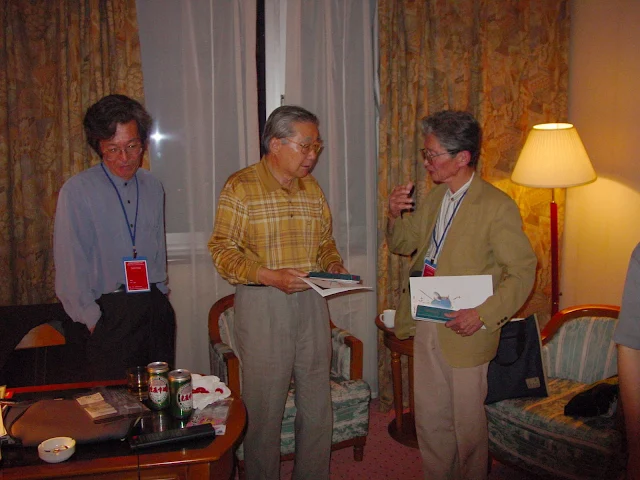対談 アジアの建築交流 回顧と展望
地に足をつけた多彩な交流を
鈴木成文 名誉会員、前神戸芸術工科大学学長、東京大学名誉教授
李光魯 元大韓建築学会長 ソウル国立大学名誉教授 大韓民国芸術院会員 工学博士 建築家
司会 布野修司
戦後日本とアジア
布野(司会):重慶でこんな場を設けることができてうれしく思います。ありがとうございます。日本の建築界は明治以降ヨーロッパをモデルとして出発しました。一方で、東洋建築史学などのようにアジアへの意識もない訳ではなかったのですが、戦後まもなくでも建築を考える時にはアジアということはあまり意識されなかったんじゃないでしょうか。ところが現在は、アジアから多数の留学生が来るなど相当状況が違ってきています。戦中の話もありますが、ここではまず戦後日本がいつアジアに目を向けるようになったのか、というところから出発して話を広げていきたいと思います。
布野:まず鈴木先生に、戦後の日本の建築界の動きを述べていただきたいと思います。先生はある段階から韓国や中国、台湾のことを調査研究されますよね。振り返って、研究を始められた理由を教えていただけないでしょうか。
鈴木:僕は伊東忠太*みたいに本当にアジアのこと考えて始めたわけではありません。何となく戦後は欧米に学ぼうという感じがあった。はじめは戦後の日本の住宅のモデルをどうつくるかというようなことを研究していました。しかしその後、もっと文化的なことに興味が移ってきて、非常に近い文化と日本を比べてみようと考えたわけです。近隣文化との比較を通して日本を考えてみようということです。
布野:それはだいたいいつ頃のことですか。
鈴木:たまたま韓国からは東大の鈴木研に何人かの留学生があって、帰国して大学の先生になっているので、その人たちと連絡をとって一緒に住宅研究をやろうということを企てました。とくに住居の問題は生活の文化に関わることだから、ただ外国からポッと行って調査しても深いところは解らない。その国の人が研究すべきだというのが私たちの考えでした。だから韓国では韓国の方と共同調査をしたのです。ただ、日本では研究の考え方や調査の方法などについては大分蓄積がありますから、そういう面では互いに交流して研究する意義は大きいと思ったのです。その後、韓国でもずいぶん実態調査・生活調査が盛んになりましたね。日本でも多くの大学でこの20年ほどの間にたいへん活発になりました。
布野:鈴木先生が韓国や台湾の調査をやられ出した頃、李先生は東大にいらっしゃったと思うんですが。
李:ええ、そうですね。私が東大に来たのが84年です。
鈴木:ハウジング・スタディ・グループ*が出来たのは1978年の共同研究が始まりです。住宅公団からの研究要請でタウンハウスの共有領域の調査が契機で、その後、新住宅普及会(現:住宅総合研究財団)の助成を得て現代住居史の研究をしたり、共同で本を何冊か出したり、自由な研究グループとして今日まで続いています。韓国住居の調査をしようというのもこのグループの議論から生れたので、85年からだったと思います。87年に住総研から報告書を出していますから。
布野:僕がアジアに出たのは78年です。東洋大に移ってすぐですけど、東大で助手をしている76年当時から、これからはアジアだろうって話はしてたんです。
鈴木:アジアのことを目的に考え始めたわけではないのですよ。初期の頃はヨーロッパに学ぼうという気持があったのですね。住居はアメリカよりはヨーロッパ。とくにイギリスやオランダ・ドイツなど。新しい住宅団地やニュータウンの見学は何回かやりました。しかしそのうちに、単に計画や技術を学ぶよりは、住居に関わる生活の問題、文化的なことに関心が高まって、それなら日本にもっと近い韓国や中国を見ようという気になったのです。近いから日本と共通する面、似ている点も多いけれど、逆に違いもはっきり見えてくる。つまり韓国や中国の姿から照射して日本の住居を考えて見ようという気持だったのです。
布野:70年代末は、韓国はまだ戒厳令下で北朝鮮問題が厳しかった。地下鉄の駅で写真をとって捕まりそうになったりして、調査をするというような雰囲気じゃなかった。韓国とか中国は近すぎて、しかも戦中のいろんな関係があるからやりにくかった。それで東南アジアに行くことになったんです。行ってみたらまた同じ事で、フィリピンでは日本の評判がひどかった。しかし、インドネシアはまだよかった。スカルノとハッタは日本の前田将軍の自宅で独立宣言の起草をしてるんですよ。
鈴木:それでいうと台湾は割合親しいですね。特に老人なんかとっても親しい。で、やっぱり韓国の方はちょっと恨みが残っている。
「日式住宅」の研究・・・・戦後日韓住宅研究交流
李: 鈴木先生は文化としての住まいを見たくなって、韓国、台湾、中国など一番近いところを調査した。似てるようでいて、違いがどこにあるのかということ。あれは私も勉強になったですね、刺激を受けていろんな調査をやりました。鈴木先生の調査する方法は韓国でも相当に生きております。
布野:僕のところの博士課程の朴重信君は日本人のつくった巨文島の調査をしています。
李:鈴木先生は日式住宅のことをやられたし、博士論文でね、仁川の街を調査した生徒もいます。
布野:蔚山大学の先生が満州の朝鮮集落調べるというようなことも始まっていますよね。
李:それも私のところ(ソウル大学)の生徒で、今は芸術大学の教授です。
布野:お互いに調査しあうことは鈴木先生が先駆的に始められたんでしょうか。
鈴木:やっぱりああいう調査は日本の影響で始まったんですかね。
李:韓国では私がそういうことをしたのと、金光文*(漢陽大学教授)とか浦良一先生*(明治大学名誉教授)の弟子がやったのが大きいでしょう。でもまあ、私の研究室で朝鮮半島を調査して住宅は相当強く問題にしたんじゃないかと思います。
鈴木:どちらかというと建物そのものの実測とかそれをCADにするとかで、生活的な調査というのはまた別ですよね。
李:鈴木先生がなされた調査を私たちもしたんじゃないかな。だから、布団があったらその布団に染みがあったとか、台所にこういうものがあったとかそういうものを私達も調査したんですよ。それが満州や、いろんなところに広がっている。
鈴木:日式住宅というのは、神奈川大学の富井正憲*さんが始めたんです。彼が韓国へ渡って農村住宅とかをやっていたら、日本とそっくりの住宅があるのに気付いた。それで、日式住宅や現代住宅の空間調査をした。その後、朴勇換*(漢陽大学教授)の弟子の李賢姫(日へん景園大学校)が、大学に入ってから自分の住んでいた家がたまたま日式住宅だと知ってね。それで、これを調査しましょうということを朴勇換に言って、朴勇換の研究室で全体的に日式住宅を調査したんです。李賢姫は日式住宅研究の延長として東大に留学して来たんですね。
李:李賢姫さんも私のところに1年か2年居ました。
鈴木:でね、富井さんがずっと研究していたのを朴勇換のところでやるからって、調べた資料千点ぐらいを漢陽大学に移したんですね。富井さんはほんとに一生懸命やってくれるんだったら、日本人がやるよりはその国の人がやった方がいいし、韓国の学会もとにかく貸してくれっていうことなので、朴勇換に渡した。
李:私が退官してからは、ソウル大学ではそういう研究はあまりされていません。日式住宅のようなことをやるのは皆、私の教えた私立大学の教授が多いですね。
布野:1951年くらいに吉武研がLV*でヨーロッパの学校建築とか病院建築とか図書館とかとにかく資料を集めるという作業から出発してますね。それで30年位経った段階で鈴木先生個人は文化的に近隣の住宅の在り方みたいなものに関心が移って来た。一方で、留学生がたくさん日本に来だしたのも大体、李先生がたぶん日本にいらっしゃったころからじゃないでしょうか。台湾なんかからも増えた。
李:学生が日本に行くようになったのはやっぱり75年あたりじゃないかと思うんです。そして80年になってもっと増えた。
.戦後韓国建築界の出発点
布野:李先生は、戦中から戦後にかけてソウルでどのように過ごされたんですか。
李:京城工業専門学校に行っていました。50人の中で6人が韓国学生であとは日本の学生。始まった時は高等工業高校だったんですけれども終戦間際に私が入る時は工業専門学校という名前でした。私が工業専門学校に入学してから一学期たって終戦になりました。野村孝文*先生が計画で、笠井先生が構造。あの時笠井先生が教務課長をしておられました。そして、古建築をやっておられた杉山信三*先生が博物館から先生としてこられた。戦争中だから、入学するや否や、鉄筋コンクリート、鉄骨造、いろいろ教えるんですよ。一学期勉強したら二学期には動員で現場行くんだといってね。藤島亥治郎*先生が書いた論文を読むと京城高等工業高校が開校して一年過ぎた時に教師になったということです。なぜかというと、藤島先生が三年生の時に関野貞*先生の助手として、夏休みか何かの休暇中に韓国に来られたことがあるらしいんですよ。その時総督府裏の建物でいろんなものを自分がかつて実習した。悪かったと言っておられました。そしてから高等工業に二年ぐらいおられて、ヨーロッパの旅に発って、それで、日本に帰って東大の教授になった。
布野:ソウル大が出来てそこに建築学科が出来たのはいつですか。
李:ソウル大が出来たのと建築学科が出来たのは同時です。ソウル大学がどうして出来たかって言うとね、あの時はアメリカが軍政なんですよ。工業大学、農業大学みんな国立なんですが、しかし、アメリカがこれはダメだといいました。ソウル大学にすべて集めてユニヴァーシティにすると言ったんですよ。農業大学は農学部にしてソウル大学をつくって皆その中に入れたんですよ。それが終戦後間も無くの1947年くらいです。これが大変な問題になった。北とつながった学生達がね、大学統合は私達の個性を抹殺するものだと言って大反対。暴動するわけですね。あれはすごかった。しかし政府が強行してソウル大学に統合する。それが46年かな。まあ、ソウル大学は47年くらいに出発したんですよ。アンソニーというアメリカ人が総長でした。そして韓国人に移ったんです。ソウル大学に移行した時は軍政だったからね。
布野:今日、平壌宣言ということで、日本と北朝鮮の関係も改善の兆しがあるのですが。
李:終戦後はほんとに大変だった。6人のうち3人は北へ行ったんです。私も相当オルグされて、一度はモスクワまで行くことを覚悟して平壌まで行ったんです。
日本かアメリカか
布野:李先生の後の世代はどうなんでしょう。例えば亡くなった金壽根先生なんかは日本に留学していますよね。
李:彼は密航したんです。金壽根は私の三年後輩なんですよ。私四年の時に韓国戦争が起こるでしょ、6月25日。金壽根は一年に入ったんですよ。それから戦争になって、私はまあ釜山の方で卒業したんですが、金壽根は日本に渡ったんですよ。
布野:少し下の世代にあたる方々、例えば今の大韓建築学会の会長金震均先生はどうですか。
李:あれも私がソウル大学教授に連れて来たんですけどね。デザインをやるんですよ。それでMITで設計で修士をとって帰って来ました。
布野:僕と同じ世代でソウル大学の金光鉉(大韓建築学会、会誌編集長)が東大で学位をとってるはずですが。
李:金光鉉も私のところで修士を取って、ソウル大学の助手にしようとしたんですよ。しかし、まだ修士取りたてなので助手の発令がなかなか出ない。ソウル大学で発令しないから市立大学に行って、そこで助手になった。助手として入ると外国留学の試験の資格が出来るんですよ。そして東京の香山寿夫(放送大学)さんの方に行ったんです。
布野:日本に勉強しに行く派と、それからアメリカやヨーロッパに勉強しに行く派がありますけど、その辺の事情はどうなんですか。
李:それはとても面白いですよ。ソウル大学出身はですね、日本に行かないんですよ。みんなアメリカとかヨーロッパの方に行く。なぜかというとソウル大学をつくった後、アメリカの方でミネソタプロジェクトというものをやってるんですよ。1950年代後半からかな。ソウル大学つくったけれど、教授が資格が無くてしょうがなかった。それでソウル大学の専任講師以上の者と非常勤講師でも学科の方で推薦を受けた者をあわせて、500人位がミネソタ大学に行ったんですよ。
鈴木:それはアメリカのプロジェクトですよね。ドクターとらせて帰しますよという約束でやった。
李:そうです。農業、工業、医学とかいろんな分野で5、6年継続的に教育したですよ。先生があっちから帰ってくるから留学生も自然とアメリカの方に推薦書を書くようになる。それと、ソウル大学出身でアメリカに行く学生は学位取りに行くんじゃないんですよ。マスターの後は設計をする。建築の設計のために行く。東大行くのは学位取るためでしょ。ソウル大学出身は早く3年あげて、設計事務所行って経験つんで帰ってくる、そういうパターンが多いです。だから、日本に行くのは漢陽大学とかの私立大学が多いですね。日本に行った留学生は、金光文、朴勇換あるいは金光鉉が、私の記憶では初めてですね。あの世代で日本に行った。
布野:アジアを歩き始めたころ、留学生に日本の教育制度がものすごく評判悪かったんですよ。まず、学位をあまり出さない。それから、ちょっと前の話ですけど、日本語で書かないと駄目とか、日本語やらないと駄目とかそういうバリアーが高すぎた。
日中韓学会の交流
李:日本の建築学会と韓国の大建築学会の話をしますとですね、吉武先生が会長をしておられた時、韓国に来られて、その時に何か同盟みたいな関係を結ぼうという話があったんですよ。そして簡単にメモもあったんです。
布野:それは李先生が会長をされていた時ですか。
李:私の前の話です。会長になって、そのメモランダムを見ました。吉武先生が韓国の建築学会と協定を結んだのは私が学会長をする8年くらい前のことです。私が学会長になったのは86年位です。
鈴木:それは知らなかった。
李:日本建築学会の理事会なんかを通じずに吉武先生が個人的に結んだ協定だったのじゃないかと思います。だけど結局その時から情報交換とかそういうものがあって、そして80年になって、病院建築の伊藤誠先生とですね、浦良一先生が来られた。そして81年ぐらいだったでしょうか、同じく病院建築をする金光文さんが韓国の漢陽大学に来た。
布野: 86年となると、日本の建築学会設立100周年ですから、今回の会議(第4回アジア建築国際交流シンポジウム)につながって来ますね。吉武先生が韓国行かれたのは。確かに早いですね。そうやって見ると、72年の日中国交回復がきっかけとしてあって、僕の記憶ですと、吉武先生とか稲垣栄三先生は中国へ先に行かれていると思います。そういう政治的な動きが背景にあった訳でしょうね。中国と関係が出来て来て、今のお話だと韓国とも正式に、あるいは吉武先生個人だったかもしれないけど、交友を深めようという気運は出てきたわけですね。その後、少し間があきましたけれど、1998年に神戸、2000年に済州島、そして重慶、2004年日本、2006年韓国、2008年のオリンピックの年に中国に帰って来ることになります。
設計教育の問題
布野:昨日、金震均大韓建築学会会長に、今韓国で一番の問題を何かと聞いたんです。教育システムの問題だと言われました。アーキテクトの教育年限を5年制にするわけですね。ソウル大学は。
李:今年から5年制。50名のうち25名がデザインで25名がエンジニアになるということです。
鈴木:デザイン系だけが5年制にするんですよね。
布野:蔚山大学も5年制に決めましたね。
李:漢陽大学もそうだけど、いろんな国立大学も私立大学も、結局韓国ではソウル大学がやったらみんな追随する。しかし、建築士に対する試験制度が昔の建築士制度ではだめなんですよ。デザイン系の学生が今やっている建築士試験は、構造とか環境(とか、エンジニアと同じくいろいろな試験があるんですよ。ある大学では科が二つあるんですよ。一つは建築学科、一つは建築工学科。総長が建築出身でデザインをやろうということで建築学科と建築工学科をつくったんですよ。しかし結局科を一つ増やしたのと変わらなかった。試験制度が同じだから結局は同じ勉強をしなくちゃならない。だから、私が今の学会長に言うのは、早く制度直さなくっちゃということ。アメリカ式の建築士試験の制度つくるとか何とかしなくちゃ。構造とか環境とかありますけど、それよりも設計の時間をもっと増やしてみっちり勉強させるべきだと思います。1人の先生が20人、30人の生徒を指導してね。今は講師あたりの生徒が多いんですよ。
鈴木:ヨーロッパにしてもアメリカにしても建築の学生がもっと少なくて、建築家を育てるでしょ。ところが韓国では日本以上に学生数が多いですね。だから建築関係の業種、あるいはそれ以外のも含めて教育しているわけで、何も建築家だけを教育しようと思っているわけじゃない。
李:それに関しては面白いデータがあるんですよ。この前の神戸の時(第2回アジアの建築交流国際シンポジウム)です。私が定年になるまでに教えた学生2,500名の卒業後の職業を調べてみたら、設計に従事する卒業生の割合が15%でした。そして50%以上が建設会社に行ってるんですよ。10%くらいが教師。韓国の大きな建設会社の社長とか専務とかは皆私の弟子なんですよ。ソウル大学出身がやっぱり頭が優秀らしいんですね。この前、早稲田大学の先生の発表を聞いたんですが、あそこは卒業生の17%が設計やっているということでした。
鈴木:早稲田は設計教育は徹底してますね。ソウル大が15%というのもすごいんじゃないですか。東大はどのくらい。何をもって設計と言うかですけどね。組織事務所も入れればかなりの割合になるでしょうね。
芸術家が育たない
李:私は今、韓国の建築家で唯一の芸術院会員なんです。建築家協会では建築は芸術だという声があります。その流れがとても強いんですよ。
布野:ちょっと不思議ですね。韓国の建築界も最初は日本の枠組みで始まっているわけでしょう。どうして芸術派が強くなったのか。アメリカの影響ですか。
鈴木:しかし、5年制は、芸術系によったからそうなったということじゃないでしょ。アメリカやUIAからの攻勢で国際規格に傾いたとか、その方向に適するようにいってるだけで、冷静に見た時、本当に芸術性を贔屓するという風な動きじゃないでしょ。入試の方も工学とデザインと明示される、あれ、元々はイギリスの影響なんですよね。明治の初めのことだと思うけれども、イギリスが日本へ来て、この教育をつくったんですよね。それが日本の教育になって、それがまた韓国へ行って。
李:それはそうかもしれません。けれども芸術的な観点から仕事をしようと思ったらですね、やっぱり、工学とはちょっと違う基準がなくてはならないんじゃないかと思うんですよ。張世洋*とかああいう人たちは学校の成績は悪いんですよ。だけどあいつは設計はうまいし、アイディアがあった。金壽根さんが死んで今の空間社がめちゃくちゃになるのを彼が救ったんですよ。それで、ソウル大学出身の芸術系統の肌合いの人たちはそこに集まっていったんですね。私の設計事務所におった人たちのことを言うと、今はいろんなものやっていて、作品は立派で収まりがいいので雑誌に出たり人気はあるんですけれども、F.O.ゲーリー*みたいなことは出来ないですね。
布野:張世洋さんとは同い年で飲み友達でした。夜中に電話がかかってくるんです。アジア大会のスタジアムのコンペを取ったと連絡があってすぐに亡くなりました。残念です。
鈴木:ヨーロッパは今まではずっと建築は芸術で来てるわけで、それから建築家といっても、もっと少数の建築家を育てているわけですね。ところが韓国は大量の建築技術者というか、建築関係者を育てているわけですね。だから17%、10%とか20%くらいが設計者になる。それはそれでいいと思います。
李:だから私はこんな結論を出すんですよ。どうして韓国からは世界的な建築家が生まれないか。やっぱり私達は工学の基礎があまりに強いんで、むちゃを出来ない。金壽根さんはめちゃくちゃやりますけれどね。例えば教会の屋根まで煉瓦でやるとか。神父さんは雨が漏る、何が名作だと言って怒ってる。そういうそしりを受けても金壽根さんはめちゃくちゃやるんですよ。私はそれが出来ない。
布野:そう言えば韓国では、あまり国際的な活躍をする建築家を聞きませんね。張世洋さんなどインドやウズベキスタンで仕事を始めていましたけれど。
李:韓国ではね、ソウル大で私があまりに工学的な基礎をごしごし教え込んだから、それで弟子たちが頭がさえないのじゃないかと心配してます。金壽根さんが何より偉かったのは、「空間(スペース)」という雑誌をつくったことですよ。
布野:韓国の中国との関係というのはどういう感じなんですか。
李:学術的交流はあまり無いですね。でもビジネスの方の住宅とかインテリアとかそういうのは相当に入っています。
鈴木:まあ日本でもそうですね。中国との関係は主にビジネス的なものです。
アジアの建築家とグローバリゼーション
李:今韓国の建築士が恐れているのは、WTOの規格が発効した時にUIAが実力を発揮すると、韓国にも外国の建築家が来て設計出来るようになることです。それで、早くUIAの基準をクリアすると焦っています。
鈴木:日本でもそうです。海外で仕事をしようとする組織事務所が一生懸命です。だけど全体としてはちょっと違うんじゃないかって感じがしますね。
布野:韓国もどんどん出掛けるようになるんじゃないですか。
李:建築士の国際資格の問題は日本でも今、建築家協会はじめ学会でも大きな問題にしていますけれど、あれはやっぱりアメリカからの経済攻勢の一環だと見るべきでしょうね。圧倒的な軍事力・経済力にものを言わせて世界支配しようとしている、それが資格問題にまで及んで来ているのだと思います。中国は既にそれになびいてしまったし、韓国もいま建築学科のデザイン系は5年制にしつつありますね。ですが、アメリカ流の建築家像とアジアの建築家像は違うのではないかと思うのです。もっと民衆寄り、と言うと少し古くさい言い方かも知れませんが、市民寄り、地域の人々と一緒になってまちづくりをする、そんな専門家がアジアでは求められているのではないでしょうか。立派な建物だけデザインするのとは違った仕事が山ほどあると思うのです。少数の芸術的建築家を育てる教育とは少し違うシステムがあっていい筈です。ただ、こういうことは主張しようとしても、今の経済力の下では潰されてしまうかもしれませんが…。
李:韓国では国際規格に対応した教育を必要とする理由がもう一つあるんですよ、韓国の財閥、政府の高官たちはね、韓国の建築家を信じていないのですよ。大きいプロジェクトはSOMとか、そういうところから基本設計をもらって来て、韓国の建築家はディティールだけやって許可を受けるという、そういうプロセスになっているんです。アッセン(貿易センター)の仕事でシカゴのSOMの事務所に行って来たんですけれど、サムソンとか、とかロッテの本社ビル、みんなSOMが模型つくってるんですよ。大きいものは皆西洋人たちが基本設計している。
布野:日本はちょっと違うといいたいところですけど、シーザー・ペリ事務所とかか活躍してますね。中国でもアメリカ人の建築家が多い。
李:しかしね、デザインというのは水の流れのようなもので、私達が優秀だったら逆に流すことが出来るじゃないか、しっかりしなければだめだと、そういう風に思うんですよ。
鈴木:そうですね。建築は文化であり地域のものなんだから、地に足をつけた仕事をしっかりやることが大事なんだと思います。
布野: 最後は少し急ぎ足になりましたが、そろそろ時間です。こうした議論の場がもとになって、様々な建築交流が展開することを期待したいと思います。本日はどうもありがとうございました。
2002.年09.月17日 重慶海徳飯店にて
対談:布野修司、李ミョンホ、鈴木
2002.9.17
F:鈴木先生にはちょっとお話したんですが、1500号記念ということであまりテーマぽいことを決めてるわけじゃないんですけれど、要するに日本の建築とか建築計画はどうあるべきかみたいな話をですね、将来に向けてやるというのが多分1500号記念ていうぐらいだろうていうことなんですけど、
F:それだったらテーマも何にもないっていうことだったんですけど、まあ、編集長としては、人を指名してそこで自由にしゃべってもらえばいいっていうかなりイージーな企画なんですけど。
議論してる間に思いついたのは、アジアの中の日本建築という話が出てきたんですけど、その意図はですね、1000号、1500号やるってのはまあ
当初はやっぱりヨーロッパがモデルとしてあって日本の建築っていうのは出発してきたということがあった。
一方でアジアというのは意識はしてきたと思うんですね。東洋建築史とか。
してきたんですけど、少なくとも戦後、鈴木先生が建築を考えられたりする時には多分あんまりアジアっていうことは、そんなには意識されなかったんじゃないかっていう。
S:(元気・出来て)ないですね。
F:ところが、現時点を考えてみたらこんだけアジアから、例えば僕んとこだけ見てみても(留学生が)いますし、まあ東大が早かったんでしょうけど、留学生が来たりとか相当状況が違ってきてるんではないか。
要するにヨーロッパ一辺倒、欧米をモデルにして来て、今でもそうだと思いますけど、それとは違う(動きがあるのではないか)
500号単位(で見ると)、500号単位とは40年とかそのくらいの単位。まあ変わって来ているんじゃないか。
それでまあ、アジアの中のって言ってみたらテーマがどうなるのかなってぐらいですけど。
それで鈴木先生にはまず、戦後ぐらいからで結構ですけども、あの
S:戦後くらいからったって私戦後ぐらいからしか知らんもん。
F:だから、僕が知ってる範囲でいうと、ある段階から韓国のことをやられたり、それから中国行かれ出したり、台湾のことやられたりしますよね。
S:ええ。
F:その辺の流れみたいなものを振り返っていただいてですね。最初にアジアと日本とか、どうして韓国はじめられたのかとか。
S:伊藤忠太みたいに、ほんとにアジアのこと考えて始めたわけではなく、
やっぱり何となく戦後はヨーロッパに学ぼうという感じがあったんですね。アメリカは間違いないんだけどね。それで、いろいろヨーロッパのことを、しかも私住宅だから、ヨーロッパの住宅をいつ持って来たかみたいなこと。
どうもそれをただ学ぶというよりはもっと文化的なことに興味があって、非常に近い、多分対岸とかっていう文化とも比べてみようと。
比べてみようっていうのはその影で照射して日本を考えてみようとそういうことを考えたんですね。
F:それはだいたいいつ頃のことですか。
S:いつ頃かな。えーと。
F:僕がいる時はそういうこと言ってなかったですね。もうちょっと後ですね。
S:そうですね、たまたま韓国からの留学生が来て、朴さんかな。
F:朴さんじゃなくてその下じゃないですか。
S:朴さんとは割合親しかったから、そういうことから朴さんと連絡を取ってはじめたんです。その前にも金ショウジンさんとか、えーとテグの大学にいる人とかに会って。
それでそんな人や朴さんに呼ばれて韓国行って。これは随分日本に近いんだけど日本と違うなとこう思ったりしたんで。で、たまたま巽君?とかそういう連中と韓国に。前にもヨーロッパへ行ったりなんか連続したしたものがあったんですけど。むしろ文化的な感心っていうんでしょうかね。
あれは何年ぐらいですかね。
F:ハウジング・スタディ・ブロック?が出来たのはいつですかね。
S:ハウジング・スタディ出来たのは…
F:僕が東洋大行ったあとかな。僕は78年に(東大の)助手をやめてます。
S:じゃあ80年くらいかな。
F:そうですよね。
もうちょっと言うと、僕も先生の資料見せてもらって知ってるんですけど、吉武研の例のLVをですね、あれやられた時の僕の記憶では確か2回目の記録に吉武先生が割振って大体イギリスですよね。学校建築
だからAJとかああいう雑誌を割振って担当して、ヨーロッパの学校建築とか病院建築とか図書館とかとにかく資料を集めるという。
1951年とか。そこで出発して、で、今の80年位、まあ30年位経った段階で鈴木先生個人は、そういう文化的に近隣の住宅の在り方みたいなものに関心が移って来たと。一つはまあその留学生が来たということだと思うんですけど。李先生が居たらその前のことも…
S:李先生が東大に来たのは何年だったんですかね。
F:僕たまたま居たのかな。(僕が)お邪魔した時にいらっしゃったんですよね。
S:ええ。
F:やっぱ80年直前くらいですかね。
S:ちょっと前かな。
F:少なくとも僕が助手をしてた時じゃないですね。
A:ついでに聞いていいですか。
F:どうぞ。
A:布野先生がアジアへ出たのはいつなんですか。
F:僕は78年に東洋大に移った瞬間からアジアへ出てます。
S:なんか東洋大にプロジェクトがあったんだっけ。
F:そう、東洋大で即プロジェクトがあったんですけど、実を言うともう助手を、76年から助手をしているんですけど、当時からそういう話はしていたんですね。安藤クニヒロってのがいてね。やっぱり内田研で助手をしていたんだけど、もう日本やってもしょうがないから(アジアを)やろうって話はしていたのね。意識としては、はっきり思い出せないですけど、これからはアジアだろうってことですよね。
S:私は元々アジアをというような意識はなかった。
F:僕はもうちょっと説明できますけどね。僕は別にメインじゃないから。
A:もちろんそうですけど、世代的にアジアに出た世代とその先生という(ところをもう少し聞きたい)。
F:僕はちゃんと証言できるのは、78年以降ですね、80年くらいから(アジアに)出だした時に、僕がソウルにいくと北朝鮮問題がまだ厳しかったですよ。まだ戒厳令やってて。
S:そうでしたね。
F:地下鉄の駅で写真とって、僕は捕まりそうになったり。
S:友田君?が空港で写真を撮って捕まったね。
F:そういうじだいですよ。ですからそこで調査をするというような感じじゃなかったですよ。
S:あの頃は向こうの先生たちと飲むとね、まあバーへ行きましょうとか言って。するとだんだんピッチが早くなって11時直前になるとさーっと帰るの。11時から外出禁止になるわけよ。
F:12時じゃなかったですか、戒厳令。
S:12時だったかな。
F:僕なんかホテル泊まっててね、上から見てると大騒ぎになるわけよ。タクシーつかまえて早く帰んないと捕まるわけよ。朴さんとか知らないでしょそういうの。
P:そうですね、子どもの頃そうだったかも。
F:そういう時代だしね、僕は韓国とか中国は近すぎて、しかも戦中のいろんな関係があるからやりにくいということで、東南アジアという、それはちょっと戦略的に設定したっていうのがあるんですけど、行ってみたらまた同じ事で、フィリピンはひどいとかね。
ひどいって言うのは日本の評判が大変なんですよ。日本画相当悪いことしているから調査なんかって言ったらすごい反発食らうわけですよ。まだインドネシアの場合はよかったんですね。なんでかって言うと例のジェネラルマエダがね、独立宣言の起草をやった、スカルノとハッタが起草をやったのは日本の前田将軍のとこで起草してるんですよ。それで開放の時に一応オランダに対して戦っているわけね。だから、あまり悪印象じゃないみたいなのがあって。前田って名前でいくと、前田先生なんかすごい特したっていうか。それから山ん中入っていって調べていてもすごい親しげにラジオ体操していたり。ラジオ体操第一、第二とか。それから軍歌を、ベチャにのってあれするとね、軍歌をうたって親しげに。軍歌を一緒に歌っていいのかなとか。だからインドネシアは多分そういう事もあるわけよ。
S:インドネシアは知らないけどやっぱり台湾は割合親しいですね。特に老人なんかとっても親しい。
で、やっぱり韓国の方はちょっと恨みを持ってる。
A:そうするとじゃあ、布野先生は(アジアに出られたのが)78年からということで、(鈴木先生は何年からということになるんでしょうか)。
F:僕の感じだとちょっと(鈴木先生の方が)遅いはずだっていう。(笑)
A:ただまあ、時期的にはほとんど並行しているということですね。その頃他にもいろいろなところでそういう動きはあったんですか。
F:学会的にはね、その前から海外/ おー、いらっしゃった。(拍手)
S:どうもお呼びだししてすみません。
L:今帰って来たところです。
F:先生、今ちょっと話を始めていたんですけどね。
S:先生が東大おいでになったのは何年でしたっけ。
L:84年かな。
S:84年ですか。
F:やっぱりそうだ。
L:84年ですね。
F:それで今日本で、あの、一般的にアジアって言いますけどね、日本とかもちろん韓国も含めて、戦後間も無くは、やっぱりヨーロッパとかそれからアメリカとかですね、西洋ばっか向いてたわけですね。
韓国もそうかもしれない。
L:そうですね。
F:それがいつ(積極的にアジアに目を向けるようになったのか)。
鈴木先生が韓国を調査されたり、台湾やられだしましたよね。たぶん李先生が東大にいらっしゃった時に。
L:ええ。
F:で、日本が少しそういうアジアのフィールドみたいなものをですね研究しだしたのはいつか。というような話を今しかけていたんですよ。一方で、留学生がたくさん日本に来だしたのも大体、先生がたぶん日本にいらっしゃったころから、台湾なんかがね。
L:学生が日本に行くようになったのはやっぱり75(65)年あたりじゃないかと思うんです。そして80年になってもっと増えた。
F:ああ、そうですね。
L:そして、日本の建築学会と韓国の建築会の方はですね、吉武先生が会長をしておられた時ですね、韓国に来られて、あの時その何か同盟みたいな関係を結ぼうという話があったんですよ。そして簡単に何かメモもあったんですね。
F:それは(李)先生が会長をされていた時ですか。
L:私の前にですね。そして私が会長になって、そのメモランダムを見ました。
S:ああ、そうですか。
F:それは知らなかった。後で調べないといけないな。
L:吉武先生が韓国に来られて、あの時建築学会の私の前々会長とメモがあったんですね。何か友好をやろうというそういう。あったんですけれども、私の聞いたところではですね、これはもう本当か嘘か分からないですけども、日本建築学会の方でそう呼応してこなかったらしいですよ。なぜかといえばあの、吉武先生が個人的にやって、日本建築学会の理事会なんかを通じなくって、そんなにしたろうじゃないかと、私達はそう思ったんですよ。だけど結局そんな、あの時から情報交換とかそういうものがあってそして、80年あの、病院建築の伊藤先生とですね、浦リョウイチ先生が来られて、
81年ぐらいだったでしょうか、病院建築に対するキングァンモンさんが韓国の勧業大学に来るようになって、それで
S:キングァンモンさんって言うのは明治大学の浦さんのところで研究して、そしてそれからドクターコースを吉武先生のところでとったという人ですね。
L:そうですね。それと、私が見たところでは学術交流があった。私が学会長になる前に鈴木研に来て帰って来て、鈴木研に来る時は副会長で、帰って来て学会長。
S:その前はキムジンさん。キムジン先生というのは朴さんの先生。
L:だからですねあの時、日本建築学会100周年の記念行事の時にはキムジンさんが参加したんですよ。私たちは4(7?)月に会長を替えるので、キムジンさんが公式に参加して、私は会長になって百周年セミナーに出席しました。第一回ですよ。
S:第一回の時はキムジン先生も、李先生も来られましたよね。
L:はい、来ました。
F:そういえば、あれは86か87年かな、吉武先生が、吉武先生が韓国行かれて、そのヒエンの話とかね。それは僕聞いてますから。確かに早いですね。そうやって見ると、やっぱり日中国交回復があって、あれは72年ですよね、中国へ先に行かれてるんじゃないですか、吉武先生とか稲垣先生とかね。
U:土浦(市浦)さんとか。
F:そうですよね。やっぱりそういう政治的なある種のあれが。まあ、単独ではそういう関係が出来て来たし。今のお話だと韓国とも正式に、フォーマルに(吉武先生個人だったかもしれないけど)そういうまあ気運は…
L:それはもう私が皆トクダンデハ?日本建築学会長と韓国建築学会長が何か協定を結んでいたんですよ。
そのメモランダムがあったんです。
F:吉武先生が会長をやられたのは東大の時ですよね。
S:そうですね。
F:そうすると70どのくらいですかね。
S:あれは70年安保の、69年でしょ東大で最後に騒動があったのは。69年の秋だか夏だかに辞められてる。
F:辞められたのはですね、僕がM2ですから、74年ですよ。
S:あ、もうちょっと後か。
F:やっぱり日中刻々回復あたりじゃないですかね、会長されていたの。分かった分かった。
少し分かりましたね。
L:それで、あの時ですね韓国の建築学会長はですね、私の記憶によればあの人、早稲田大学を二年で中退した方なんですよ。戦前に。
S:(李)先生の前の前の学会長ですか。
L:前の前の前でしょう。1年だか2年だか。
S:その次がキムジン先生ですか。
L:キムジンさんは私の前。そして、その前はまた他の先生。その前はまた他の先生、そしてその前。だから8年くらい前。私が(学会長になったのは)86年位です。
F:たぶん87年じゃないかな。86か87年。だから、86年となると今回の会議につながって来ますから(今年2002年に中国・重慶で開催された第4回アジア建築国際交流シンポジウム)あれですけど。(李)先生なんかは、さっきお聞きしていたんですけど、ソウルで、韓国人の…
L:じゃなかったんですよ。50人の中で6人が韓国学生。あとは日本の学生。始まった時は高等工業学校だったんですけれども終戦間際に私が入る時は工業専門学校といったんですよ。
S:ああそうですか。広島へ行かれた先生方がおられたでしょ。
L:歳をとった先生ですか。
S:いえ、日本人の。
L:私が工業専門学校に入学してから一学期やって終戦になったんですよ。
F:野村コウブン先生。
L:そう、野村コウブン先生が計画で、カサイ先生が構造で。あの時カサイ先生が教務課長。そして、私達が学生の時に古建築をやっておられた杉山シンゾウ先生が博物館から先生としてこられた。あの時は戦争中だから、入学するや否や、鉄筋コンクリート、鉄骨造、いろいろなもの教えるんですよ。日本の学生たちも材料学やら。これどないするかといったらね、一学期したら二学期には動員、現場行くんだといってね。建築構造のカサイ先生なんか質問したら、本を読んでおれ、もうそれだけ。そして一学期過ごしたんです。
あのですね、藤島亥次郎先生が書いた論文読めばですね、京城高等工業が開校して一年過ぎた時に自分が教師になったということです。それはなぜかというと自分が三年生の時に関野貞先生の助手として、夏休みか何か休暇中に韓国に来られたらしいんですよ。その時総督府(裏)の建物(を官邸府?と言ってそこ)でいろんなものを自分がかつて実習したと、悪かったとこんなこと言っておられました。そしてから高等工業に二年ぐらいおられて、ヨーロッパの旅に発ったんですね。で、帰ってこられて東大に行った。だから京城高等工業は2年ぐらいしか居なかった。
S:それでも行っていたんですね。二年ぐらいですか、そうですか。
F:当時は洋行しないと必ず教授になれないという、条件だったんでしょ。
L:そう、だから帰ってこられて東大の教授になられて。それは藤島先生が書いておられますよ。
S:藤島先生が東大に来られたのは、私も伝え聞きだから知らないけど、その上の若い建築史の先生が亡くなられたんでしょ。天才といわれた。
F:長谷川テルオ。で慌てて洋行して来た。
L:藤島先生の書いたところによるとですね、教師として赴任したら、建築材料とか建築衛生、そういうものを教えろというんです。先生がおらんからですね。私は歴史なんだからどうしようかと思っていたら、伊藤忠太先生が来られたらしいんですよ。それで、先生これはめちゃくちゃですと言ったら、伊藤先生が、あなた、建築はいろいろの勉強をしなくちゃならんと言ったらしいんですよ。それで自分がいろいろの科目を教えたと、そういうことが書いてありますね。
F:藤島先生は、僕は二回位インタビューしたことあるんですけれども、元々はバンドンに行かされそうになったんですって。バンドン工科大学、だからインドネシアね。で、ところがそこには行きたくないと言っていて代わりに行かれたのがチハラダイゴロウ先生。京大の建築で、俺助かったと言っていましたけれどね。その代わりソウルに行かされて、そしたら2年でそういうことになったらしいですけどね。
S:李先生は藤島先生の書いた本を翻訳されたんですよね。藤島先生にも会われてますよね。
L:私は翻訳をしてですね、そして、一昨年私の五番目の娘が東大に一学期居ったんですよ。藤森先生のところ。その時一緒に藤島先生のところに行ったんですよ。あの時105歳。
S:(その)前にも行っているでしょ。
L:前にも行きました。本を翻訳する前とその後にも。
S:明治、大正、昭和、平成
L:私の娘にも東京に居るならちょいちょい来なさい。特に古建築するなら私のところにいろいろな本があるとおっしゃったんです。
F:これドンピシャですね。それで話がつながるからこの50年くらいは。
それで、(李)先生の時代は、ソウル大が出来てそこに建築学科が出来たのはいつですか。
L:それはそのまま京城なんですよ。
F:大学になったのは。
L:それはですね、1945年、昭和20年に終戦になって、私達は工業大学と名前を変えたんですよ。そしたらね、あの時は韓国の教育制度が、帝国大学、そして帝国大学の予科があったんですよ。そして高等技専、高等工業、高等商業、そして鉱山、そして法科、それがあったんですよ。そして私が入学する時にはね私の中学、あの時は中学校だったんですよ。4年生から上級学校の受験が出来るんですよ。私は4年を修了して、受検したんですけれども、あの時はとても優秀な学生じゃなきゃ受けられないんですよ。私はソウルの名門の中学校を卒業したので、そうですね、200人の中で私は4、50番ですね。10番くらいだったら帝国大の予科の受験の資格があるんですね。で、その次が、高等工業とか高等技専、まあそういうものに行くことが出来たんですね。
S:(高等技専では)イシコロ、イシコロって言われてたんでしょ。
L:ああ、イコロだかゴロ。あの時教練がとても厳しかったですね。
F:それであの、先生の世代があってですね。
L:あ、そう。ソウル大学がどうして出来たかって言うとね、あれはですね、政府の方で見たら、みんな国立なんですよ。工業大学、農業大学みんな。
あの時はアメリカが軍政なんですよ。アメリカが軍政なのでこれはダメダと、ソウル大学に集めろと、ユニヴァーシティにすると。そして農業大学は農学部、皆そのソウル大学をつくってその中に入れたんですよ。
S:それが何年くらい。
L:それがですね、1947年くらいです。
S:じゃあ戦後間もなくですね。
L:あれが大変な問題になった。ハッカ?あの北の方のあれやる学生達がね、何を言うかと。私達の個性を抹殺するものだと言って。それで国立大学反対。
F:ああ、暴動するわけですね。
L:あれはすごかったですよ。それこそ政府の方で強行してソウル大学に統合する。あれは46年かな。
(ソウル大学は)まあ、47年くらいに出発したんですよ。
S:大統領はリショウバンですね。
L:いやリショウバンになる前ですね。アンソニー?というアメリカ人が総長になっていたんですよ。そして韓国人に移ったんだけれども、ソウル大学に移行した時は軍政だったからね。
S:ああ、なるほど。
L:そして、3、2年私勉強しなかったからね。ほんとに休学だとかなってね。
F:先生はそっち(北と連帯)の方じゃなかったんですか。
L:いやー私はですね。無産階級のためにやって何が悪いのですかと、そりゃもちろんそうです。
F:若い頃は赤旗振らないとそりゃダメだ。
L:韓国人学生6人でしょ、建築学科の。3人は完全に共産党なんですね。3人だけが私ともう2人が違う。その人たちに連れられてですね、もう、共産党の創立大会とかみんな行くんですよ。ただ私は、みんな政治家になったらどうするかと、私は一塊の煉瓦になる。したらね、こいつらがね、私たちの世代は犠牲にしなくちゃならん。お前の腐った精神では何が煉瓦かと言ってね。ボロクソや。
あの三人の中でね一人は釜山の人間だったんだけどね、あれがチー(チュイ)サンのパルチザンの総大将してたんですよ。そしてあいつが結局最後に共産党パルチザン掃討完了。私の同僚を射殺、って新聞で読んだんですよ。
だから六人のうちの三人が共産党。卒業してから3人はそのままで、3人は他の日本とかでいろんな勉学し来た人ですね。
ほんとに悲惨な目に合ったんですね。
S:47年って言ったらまだ朝鮮戦争の前でしょう。
L:キムジョンイル?がセットする時ですね。北で宣伝するでしょ。私はそれを嘘だと言ったんですね。そしたら総大将やってたやつがじゃあ見て来いと。で、私北朝鮮に行きました。平壌の所に行って労働したりですね、
F:こういう話活字にして大丈夫ですか。
L:ええ、そりゃもう… そん時はですねとても目まぐるしい思想的な闘争があったもんですからね。
F:鈴木先生のお話し聞かれたこと有りますか、その頃の。鈴木先生だっていろいろありますよ。
L:ああ、そうですか。日本の学生に袋叩きにされて終戦を迎えて、その六人が思想的に別れてですね、下宿の部屋でお前共産党に加盟しろといわれて、いやしない。ばか野郎。みんな嘘だと。じゃあ行ってみろと、じゃあ私行ってみてですね。
S:そんな簡単に行けたんですか。
L:いやー、簡単じゃない。歩いて行って、ロシア兵に捕まって監獄に入れられたりしてね、たたかれたり。私の考えはこうだったんですよ。万一共産党が良ければ、そこにも日本のつくった工業大学とかそれから工業専門があったから、そこからモスクワに行って、行くならね。そういう覚悟で行ったんですよ。 だがそれは違うね。仕事していたらお前はなしが南だスパイだと。でも鞄開けたら共産党宣言とか毛沢東とかの本が入れてあった。私理論があいつらより上なんだよ。学生生活やってたから。どうしてあんた労働するかと。お前話がうまいから共産党行きなさいといわれて、いや私もう家がないんだから働かなきゃと。ああそうか、ごめんなさいと。
で、逃げてかえって来た。もうだめだと。
行く時と帰る時はまた違った。帰る時はもうシャッター閉じてもう入れない。帰って来たらもうあの3人はいない。どこかに隠れているの。捕まると監獄に入るから。地下に入ったんですよ。そういう時代があって、まあソウル大学で、仕方がないから建築をしたんですね。
S:帰って来てもまたなんかやられるとか無かったんですか。
L:私はもう政治のところに行かんですから。私はもう一塊の煉瓦になると。
S:その時はもう日本の先生達は帰られていたんですか。
L:ああ、だからあの時イーインソと言って、日本の時井村という先生が居ったんですけど、あの先生が日本の時代に助教授になって、あの助教授が万年助教授なんですよ。年は野村先生と同じくらいなんですけど、井村君ですね、助教授だから。
その先生が日本から来た。その井村という方が製図とか素質が無いので、お前学校に来いといってある時、藤島先生のところに呼ばれたらしいんですよ。助手として散々こき使って。50何年くらいね。あれ偉くなってたよって。その時は一人の教授なんだから。
F:ソウル大で話してしまった方が早いから、例えば今の会長さん、キム先生。
L:それは私の教え子の若い教え子です。
F:そうですよね。その前にちょっと、例えばキムスクン(ジュソン?)先生なんかは日本に留学していますよね。
L:あれも、キムスクンもね私の三年後輩なんですよ。なぜかといえば私四年の時に韓国戦争が起こるでしょ、6月25日。
F:朝鮮戦争といわないんですか。
L:そう、朝鮮戦争。とにかくキムスクンがあの時一年に入ったんですよ。
で戦争になって私はまあ釜山の方で卒業したんですよ、キムスクンは密航したんですよ日本に。
F:密航ですか。
L:あれは密航ですよ。その話したらまた長い。
F:それはすごいなあ。彼は釜山の出身じゃなかったですかね。
L:そうですか、いやあ、あれの親父は北の方ですよ。
F:密航ですか。
L:でもキムスクンの中学は名門ですよ。キンキ?中学。
F:それで今言いたいのは、日本にこられた、何人かの(李)先生より下の世代がいらっしゃるわけですよね。今の学会長をしていらっしゃるテイキムキ?さんとかね。
L:あれも私のところで、私がソウル大学教授に連れて来たんですけどね。あれはデザインをやるんですよ。それでMITでも設計で修士して帰って来て。もっと博士しろと言ったら、ばか野郎デザインで何の博士かと言って、その後に学校の先生やって。
F:とられたんですか、学位。
L:あれ、学位はもういいんちきじゃないんですか。私立大学の方でまあ、やったんでしょう。
F:次に僕と同じ世代でチンコウゲンってのが香山先生のところで学位とってるはずですが。
L:チンコウゲンも私の弟子の弟子なんですが。チンコウゲンも私の修士で、ソウル大学で助手にしたんですよ。そしたら、まだほやほやなので助手の発令が出ないんですよ。あの時ソウル市立大学が出来て、そこに助手として入ったんですよ。助手として入ると外国留学の試験の資格が出来るんですよ。だからソウル大学で発令しないから市立大学に行って、そこで助手として、いや講師になったかな。そしてそれから東京の香山さんの方に行ったんです。
F:それで今だいぶ世代下げたんですけどね、僕が今聞きたいのは、先生全部知っているじゃないですか、ソウル大については。要するに日本に勉強しに行く派と、それからアメリカに勉強しに行く派があったりして、これはヨーロッパも含めてね。これはだから今日のテーマだけど、日本がヨーロッパとアジア 学会との関係は少し分かった。
先生は日本はとんでもないと思ってたりするかもしれないけど、日本派の代表でしょ、たぶん。
L:そうでもないですよ。
S:(李)先生はアメリカにも行ってらっしゃるしね。
F:その辺の話を聞きたいですね、まず。
L:それはとても面白いですよ。ソウル大学出身はですね、日本に行かないんですよ。
みんなアメリカとかヨーロッパの方に行く。
F:何でですか。
L:わからん。
F:いや、分かってるくせに。
L:そうでもない。
ただ、日本に行くのは市立大学ですね。勧業大学とか他の学生、卒業生が日本の方に行ったんですね。キンコウブンとか
F:ハンヤンファンとか。
L:そういう方たちが日本の方に行かれたんですね。そしたら結局政治家っていうのはヨーロッパの方に、やっぱりそうでしょ。
ソウル大学をつくった時にアメリカの方でこういうのもやってるんですよ。ミネソタプロジェクトと言って、ソウル大学つくったけれど、教授がしょうがない、資格が無い。それでソウル大学の専任講師以上は、時間(非常勤?)講師でも学科の方で推薦したら、500人位がミネソタ大学の方に行ったんですよ。
S:それはアメリカのプロジェクトなんですよね。
L:そうです。
S:そういうのやって、ドクターとったら帰りますよって。
L:そうです。あの頃契約書見たら何%はマスター、何%はphDってこうなってるんですね。だからあそこで5、6年継続的に教育させたんですよ。で、農業、工業、医学いろんな分野で。で、先生が帰ってくるから留学生も自然とアメリカの方に推薦書を書くとかして。そうですね、だから、キンコウブンがあいや、キンコウハンあるいはキンコウゲンが、私の記憶ではあれが初めてですね。
F:あの世代で日本に来る。
F:カンは出てないでしょ東大は。
L:いやいや、今有名な火災なんかやるインヨゴ?という人が岸谷研?に居るんですけれどもあの人の下で。
F:エンジニア系ですか。
L:そしてソウル大学出身は皆アメリカとかフランスとかそういう所ですね。
F:何でですかって言った時に、僕は分かってるんですよ。あの、韓国はそういうことですけどね、あの僕のところに例えばインドネシアとかタイとか(留学生が)いますけどね、ものすごく評判悪いんですよ日本は。まず、学位あまり出さない。それから、ちょっとだいぶ前の話ですけど、日本語で書かないと駄目とか、日本語やらないと駄目とかそういうバリアーが高すぎる。
S:バリアーというより日本はアメリカみたいに政治的なことは、お坊ちゃんだから全く頭になくて、同じようにレベルを設定している。
F:そうですよ。だから今でも日本に来てるんだから日本語しゃべるの当たり前だとかね。そりゃ一理あるかもしれないけど、そういうのは今でもありますよ。
所がですね、もうちょっと先走って言うと、日本も一年間にアジアから例えは1、000人取りますというと、今度はいっぱい来出したわけ。
L:ああ、そうですか。ソウル大学出身はですね…
F:でも、それ(ソウル大学の学生)は全然引っかからない。
L:建築の方ではですね、実際アメリカに行く学生は学位取りに行くんじゃないんですよ。マスターの後は設計。建築の設計のために行くんだから。東大行くのは学位取るためでしょ。早く3年あげて、設計事務所行って経験つんで帰ってくると。ソウル大学出身はそうですね。
F:その話でいくと、またこれも先走りますけどね、キム先生(韓国建築学会会長)と昨日しゃべったんだけどね、今の韓国で何が一番問題ですかって聞いたら、そしたらやっぱり今の教育システムの問題で、アーキテクトWTO対応で五年制にすると。それが今一番の、まあ彼適任ですよね。アーキテクトだし。そういう教育システムにすると。
L:そうですね。だから今年から五年制。昨日聞いたら50名のうち25名がデザインで25名がエンジニアになる。
S:デザイン系だけが五年制にするんですよね。
F:そう言ってました。ウルサン(大学)ももう(五年制に)決めて、ハンヤン大学はまたちょっと違うみたいですけどね。4+2か。
L:まあ、カンニョーもそうだけども、いろんな国立大学も私立大学も、結局韓国ではソウル大学がやったら皆追随する。だから私立大学で建築学科と言ったら、ソウル大学がやるのになんでお前のところはやらないんだという風になる。だからソウル大学でやれば皆ぽつぽつ来るんですけれども、いや、問題は大きいですよ。
S:問題というのは。
L:というのは、制度がね、建築士に対する試験制度が昔の建築士制度ではだめなんですよ。なぜかというとデザイン系の学生が今やっている建築士試験はね、構造とか環境(=計画言論)とかそれからいろいろな試験があるんですよ。エンジニアと同じね。
カンギョウ大学はどうしたか。カンギョウ大学は科が二つあるんですよ。一つは建築学科、一つは建築工学科。あの時つくったのは総長が建築出身でね、デザインをやろうということで建築学科と建築工学科をやったんですよ。結局科を一つ増やしたのと変わらなかった。なぜかというと、高校卒業しても(デザインだけでは)建築士試験に受からんのですよ。建築士試験受けるにはですね、一旦学校卒業して、必死で勉強して建築技師になって3年か4年して建築士試験受験の資格が出来るんですよ。だから田舎の学生たちは設計しないんですよ。4年になったらその学院に行ってその勉強するんですよ。結局カンギョウ大学で(デザインを)やってみたら、卒業しても結局工学系の授業がないから、だから皆同じようになってしまう。だから、私が今の建築学会長に言うのは、早く制度直さなくっちゃということ。アメリカ式の建築士試験の制度つくるとか何とかしなくちゃ。
F:日本でも大問題になってるんですけど、日本はまだ中々どうかなと。(韓国のように)薫陶がきいてる範囲ならまだ簡単そうであって、日本は中々難しそうだな。
L:僕はその方(4+2年)がいいんじゃないかと思いますけどね。
F:アメリカにもそういう声がありましてですね…
L:いやーそれも分かりますけど、私の理解ではですね、構造とか環境とかを工学とか?何とかに分かれてね、それよりも設計の時間をもっと増やしてみっちり勉強させると。それとですね、一人の先生が20人、30人の生徒を指導して。芸術の方ではですね、講師が多いんですよ。
F:講師というのは非常勤講師ですか。
L:そう、非常勤講師ですね。だから設計の勉強をもっとみっちりさせた方がいいんじゃないかと思ったんですよ。
またアメリカの学校はWTOとか何とか言って、中国のほう精華大学で得に何とかいってね、まあ私達はそういう事を五年生の子に言っていくんだから。
S:ヨーロッパにしてもアメリカにしても建築の学生がもっと少なくて、建築家を育てるでしょ。ところが韓国では日本以上にもう学生数多いですね。だからもう建築関係の業種に行く、あるいはもうそれ以外のも含めて教育しているわけで、何も建築家だけを教育しようと思っているわけじゃないんでしょ。
L:いやそれはですね、面白いデータがあるんですよ。この前の神戸の時です。私が実は定年になるまでに教えた学生は2,500名いたんですよ。その卒業後の職業を調べてみたらですね、設計に従事する卒業生の割合は15%ですよ。50%以上が建設会社に行っていたんですよ。10%くらいが教師、教授以下の。韓国で(チジュとかナンコウとかで?)今、建設会社の社長とか専務とかは皆私の弟子なんですよ。ソウル大学出身がやっぱり頭が優秀らしいんですね。で、みんな建設会社とかいろんな所行く。
この前、早稲田の方で先生が発表するに、(卒業生の)17%が設計やっとってとか言っておったんですよ。
F:早稲田はもしかすると日本で唯一そういうことが言えるかもしてない。ソウル大が15%というのはすごいですよ。東大はどのくらいか。何をもって設計と言うかですけどね、たぶん。組織事務所も入れれば行ってますねかなり。
S:10%~20%の間かな。
F:京大なんか全然だめですよ。たぶん5%もいってないんじゃないか。3%とか、悲惨だな。
L:いや、私は今、韓国で唯一の芸術院会員なんですよ。
F:建築系でですか。
L:美術系ですね。美術系が今20名居るんですけど、画家とか彫刻とか。その中に建築家が私一人居るんですよ。だから、建築は建築家協会でやっとれば、建築は芸術だと、そういう声があるんですよ。その流れがとても強いんですよ。
F:それでちょっと不思議なのはね、僕が勝手に解釈すると、やっぱり日本の枠組みで始まってますでしょ、どうしても最初は。
L:そりゃ、まあ。
で、ずーっとそういうので来て、どうして今の芸術が強いみたいに(なったのか)。いろいろ問題があるにしても。
L:いや、建築というものはですね、やっぱり、ものをつくるんですよ。だから教育の方でですね、私構造の計算を4年か5年くらいやったんですよ、だからこうやって建物見たらですね、コンクリート壁は相当だなとか想像できるんですよ。そしたら私はその、ラーメンとかでは内藤多仲さんのあんな感じでですね、勉強したんですよ。先生おられなくても。で、構造の計算もしたんですよ、若い時は。
A:へー。
F:へーっ、て言うか普通だよ。
L:そうです。みんなそう。この頃環境(=計画言論)だなんて言ってるけど、私ソウル大学の方で若い時は建築言論なども教えたんですよ。なぜかといえば計画系の、他の先生が
Tape2
S:何もね、五年制ということはね、韓国でも芸術系によったからそうなったということじゃないでしょ。ただ、アメリカからの攻勢?で国際規格とか…
F:UIA。
S:そう。その方向に適するようにいってるだけで、冷静に見た時本当に芸術性を贔屓するという、そう言う風な動きじゃないでしょ。
L:まあ、そりゃそうでも、建築というものはやはり独自の世界なのに?
S:それでやっぱり、入試の方も工学とデザインと明示される、あれ、元々はイギリスの影響なんですよね。明治の初めのことだと思うけれども、イギリスが… 大体ヨーロッパでは建築家は芸術的とか、デザインとか、あれはどこだっけ… それでイギリスが××になって日本へ来て、この教育をつくったんですよね。それが日本の教育になって、それがまた韓国へむかって。
L:そうですね。
S:で、それは一つの工学っていうんですかあるいは科学的な(××点という)建築が普通になって来た。今でもヨーロッパの方でもですね、それがいいって言う人も居るわけですよ。だけど今まではむこうはずっとそういう形じゃなかったから、ずっと芸術で来てるわけで、
それから建築家っていっても、もっともっと少数の、数少ない建築家を育てているわけですね。
ところが韓国は大量の建築技術者というか、建築関係者を育てているわけですね。
L:そうです。
S:だから17%というのは。10%とか20%くらいが設計者になる。それはいいと思います。だから私は今でも一学年80人教えているわけですけれども、ちゃんと見たいならそういう方向に行けばいいんじゃないかとそんな風に思っています。
L:だから渡しはこんな結論を出すんですよ。どうして世界的な建築家が生まれないか。やっぱり私達は工学の基礎があまりに強いんで、むちゃくちゃ出来ない。キムスクンさんは、あいつめちゃくちゃやるんですよ。そして雑誌に出すんだけど、例えば教会の屋根まで煉瓦でやるとか。神父さんが雨が漏ると、これが何が名作だと、そういうそしりを受けてもキムスクンさんはめちゃくちゃやるんですよ。私はそれが出来ない。
S:だけどそりゃ、世界的な建築家も結構出ているじゃない。日本でいえば…
F:いや、だけど、そう言えば韓国ではあまり聞きませんね。
L:韓国ではね、ただ私が教えた、(韓国で建築にいる人は皆ソウル大学出身なんだから)、私は一層、あまりに工学的な基礎がごしごしやったから、その、あいつらが頭がさえないのじゃないかと。
F:キム先生はだから忙しすぎて亡くなっちゃったでしょ、ソウルオリンピックでね。 あそこの下にチャンセイアン(セヨン)ってのがいましてね、あれは僕と同じ歳。飲み友達で。
L:セイアンは私の弟子なんですよ。
F:もちろん分かってますよ。飲みすぎて死んじゃったんですよ彼も。
S:ついこの間現代美術館で、一昨年だったかな、チョウコウサン(コウソウ超高層?)ってのは。
F:シンヨウサン。
S:あれはチョウさんぐらいですか年齢でいうと。
F:僕と同じくらいですよ。
S:あれ、人気があるんですよ、私は行かれなかったんだけど。
F:おとなしいんですよ。
L:まだまだですよ。
F:先生にかかると皆まだまだ何じゃないですか。
S:喪家、韓国で世界(的建築家)っていう人はあまり出てませんか。
L:でも、あれですね。
F:その、チャンセイアンが言ってたのは、まあ世界って話じゃないですけれど、コンガンシャ(空間社?)がどこだったかなウズベキスタンとかね、ああいうロシア系から仕事が来てるとか、いっぱい仕事が来てるとかなんか言っていた。
L:いやね、あるんですよ。もうからなくてもいろいろ。やっぱりキムスグンさんが偉かったのはね、雑誌をつくったんですよ。「SPACE?」という雑誌をつくって。
F:(韓国の)中国との関係というのはどういう感じなんですか。あんまり無いんですか。
L:無いですね。でもビジネスの方の住宅とかインテリアとかそういうのは相当に入っています。
F:いつ頃からですかそういう関係は。
L:それは、××年くらい前から。
F:そうですか。
S:日本でもそうでしょ、中国との関係はビジネス的なものでしょ。
L:そうです。
F:あれ何でしたっけ、日中技術交流なんとか協会って、あそこ入ってるのが出来たのは随分前でしょ。
S:あれはだいぶ古いです。
F:古いですよね。
L:今(韓国の)建築士が恐れているのはですね、WTOのほうで何年かして(××が発効した時に)、UIAが実力を発揮すると、韓国の方にも外国の建築家が、皆設計出来ると。じゃあ私達も早く行かなくちゃならない。だから早くUIAの基準をクリアするということです。それだと建築設計事務所やる人たちもその…
S:日本でもそうです。日本でも大体海外と、まあ日建とか日本設計とかそういう人たちが、そういうことに一生懸命で。だけど全体としてはちょっと違うんじゃないかっていう。
L:実感(時間)が無いんですよ。
F:だから、必要ないんじゃないですか、僕なんかの意見では。だってJV組めばいいだけの話じゃないですか。
S:だから4+2でいいんじゃないか、建築学科全体をそれ(五年制)にしなくてもいいんじゃないかっていう感じを私はもってます。
もう一つはね、ヨーロッパや特にアメリカ的な建築家と、アジアの建築家とはちょっと性格が違うんじゃないかっていう気がしているんですよ。何というか、民衆寄り、庶民寄りというか住宅とか一般的なものをもっと良くするっていう方向であって、何もデザインをするっていうのとはちょっと違う制度になると私は思っています。
L:でも、きっかけというものはそうなんですけれども、設計やる、とにかく芸術的な観点から仕事をしようと思ったらですね、やっぱり、工学とはちょっと違う基準がなくてはならないんじゃないかと思うんですよ。まあ(チャン)セイヨーとかああいう人たちは学校の成績は悪いんですよ。だけどあいつは設計はうまいしね、アイディアが何かある。
F:すごかった。随分付き合いましたけどね。チャンセイヨーさんてね、キムジュホン?さんの後を継いだひと。僕と同じ歳の人だったかな。朴(ヤンファン?)さんが良く知ってましたよ。
L:男ですよあいつはものすごく。
F:釜山出身で、最後やっぱ今度のアジア大会のスタジアムやってる時に死んだ。
L:今の空間社?をですね、キムスクンさんが死んであれがめちゃくちゃになるのを彼が救ったんですよ。
F:ところがその跡目相続が…僕相当詳しいですよ。
L:だから今、あの会社はもう豪華じゃないですよ。皆もう、負債ですよ。
あれ、チャンセヨン(セイアン)が、自分の親からもらった金が、兄貴と分けて、何億あるって私に言ったんですよ。
これからは私が(空間社を)引き受けていいんですかね。金はあるのか。親からもらった金がね、あるんですけど。株価はみんなお前が取ったらいいんじゃないか。お前まだ若いんだからひとつやってみ。それで株を自分が受け持ったんですけどね。それで苦労したんですけどね、まあ、やっぱりあれも男なんですよ。ソウル大学出身のそういう芸術系統の肌合いの人たちはそこにおったんですね。
F:そうですね。
L:私の弟子たちは、私の設計事務所におった人たちもまあ、今はもういろんなものやってるんですけれども、私の門下生の作品はもちろん立派だし、収まりがいいし、だからその人気があるんですけれども、雑誌に出て何とかまあ、ゲーリーみたいにそういうことは出来ないんですよこいつら。
F:ゲーリーみたいに。ちょっと話しを広げますけれども、韓国の建築の、その今のレベルの話じゃないけれども、アジアの国でいうと今中国はまだ分かんないけど、本当はここに中国の長老もお呼びしたかったんですけど、中国はなんか若い重慶の人たちばっかだったんで、もうビッグ2にしましたけど、ここタイの学生もネパールの学生もいますし、
なんか外からやられるって話もありますけど、さっきのチャンさんのウズベキスタンみたいに、出かけていっていろいろ仕事する時代になって来ているんじゃないかっていう。
L:まあそう、香港とか、シンガポールとかそういうような所には行っておりますよ。だからあの人たちはWTOを心配しているのですよ。その、資格を持ってないしね。
F:なるほど。
L:まあ一生懸命何かやろうとしておるんですね。
S:日本でも資格問題でもめているのは、外で仕事をするからということでしょ。
F:そうです。
S:だから外で仕事をする人たちがそれを取ればいいわけだから、別に今までどうりでいいんじゃないかっていう…
L:それがですね、韓国の方では(国際規格に対応した教育を必要とする理由が)何でかといえばですね、韓国の財閥、政府の高官たちはね、韓国の建築家を信じないわけですよ。大きいプロジェクトはSOMとか、そういうところから基本設計をもらって来て、韓国の建築家はディティールをやって許可を受けるという、そういうプロセスなんですよ。実はアッセン(貿易センター)というものはですね、私はあの建築の諮問委員長なんですよ。SOMの方でしたので、私はシカゴの事務所に行って来たんですけれどね、あのオフィスね、エルジーとか、サムソンとか、ドテ(ノテ)とかロッテの本社ビル、みんな(SOMが)模型つくってるんですよ、もう。だから韓国の方には、とってもあの人たちはもう入っているんですよ。大きいものは皆西洋人たちが基本設計している。
F:そうか、そういうものなんだ。
L:だから若い建築形は恥ずかしいと、何だ、財閥の資本主義の奴等非愛国だと。私はお前たち実力でもって見せなさいと。
F:日本はちょっと違うといいたいところですけど、結構、シーザー・ペリ事務所とかにやられてますよ。
L:それは私も数年前に日本を見に行った時に感じました。日建と大成に紹介されて、ランドマークタワーを見に行きました。あれは基本設計はハーバードの人がしとるじゃないですか。
F:三菱地所かと思ってた。ああ、そうですか。
L:そうか、アメリカが日本で基本設計をして、日本の設計事務所は韓国に来て基本設計をして、水の流れのようなものだなと。
そういうことを思ったことがありますよ。
F:日本は、バブルの時は名前を借りるんですよ。
S:そうですね。
F:例えば、マイケル・グレーブスにお金を払って施主をこう…だからもうちょっと複雑なんです日本は。名前を借りて、実は日建設計がやってるんだけれど、施主は納得させといてとかね。もうちょっと複雑ですね。でも、おっしゃる通りですけれど。
L:ああ、なるほど。
貿易センターは、初めは日建の方でしてたんですけれど、日建の方で持って来たアイディアはちょっと私のセンスに合わんのですよ。で、新しくつくったパーセン(プレゼン)?はSOMだった。その時私は思ったんですよ。デザインというのは水の流れのようなもので、私達が優秀だったら逆に流すことが出来るじゃないかと。しっかりせいと言って。
F:中国どうですかね。今の重慶見られて。
L:いや、あれはまあ何といいますか、立派なもんですけれども…
F:立派なもんですか。
L:めちゃくちゃですね。
一番広い面積を持っている人たちがどうしてここに集まって来て、密集しておる。あんなに出来るのはね、八階まではエレベーターなくていいらしいんですよ。
F:十何階で、あれは水の問題ですかね、切り替るんですよね。
L:やあもう、上海ももちろん立派なんですけどね、結局あの(高層ビルの)設計は皆外国人でしょ。中国人の設計はないんですよ。
F:いやまあ、育ちつつあります。これあんま活字にしませんけどね、中国の人がおられませんので。
L:いやいや居ってもいいんですけどね別に、やはり私は上海見てもですね、この河の東方の新しい都市よりもこちらの昔の、村松伸さんが調査した、昔の租借地の辺は何か出来たかなとか、あそこはもっと忙しいん(急ぐべき?)じゃないかと思うんだよね。
S:バンド地区
L:やっぱりいろんな特徴ある建物が建っておるんだけれども…
S:けれど、あれだってその当時の外国の人が設計したんだよ。
L:いや、とにかく、街並みがね、こちらの方でも立派なビルディング建っているんだけれども、あれもめちゃくちゃですね。勝手にやってしまったから。重慶の建物なんかデザインがもっとひどい。
昨日私は聞いたんです、重慶の人たちに。あの重慶の建物お前がやったのかって。そしたら、いや違います、あの年取った人の学生がやりましたって。
S:そういうのは日本のマンションでも、韓国の高層住宅でもそうなんですよね。
L:いや、高層住宅みたいのでは反対をしてですね。ここに来てみると、韓国はまだいい。
S:かわいいもんだ。
L:いやあすごいですね。まあ、日本ではああいう高層はだめでしょうね、地震があるので。
F:もうだいぶ時間使っているけど、どうしますか。
L:いや、私に聞きたいことがあったら聞いてください。
F:何か聞きたいことがあったら。
A:最初のあたりをもう少し詳しく聞きたいですね。
F:鈴木先生が韓国調査したりとか台湾調査したり、中国調査したりとか、不思議は不思議ですね。
先生は文化としての住まいを見たくなったと。そうすると一番近いところをやった。似てるようでいて、違いがどこにあるのか。
L:あれはもう、私も勉強になったしですね、刺激を受けていろんな調査を(やった)。いいことだと思うんですよ。
鈴木先生の調査する方法がね、相当に(韓国でも)生きております。先生のお宅にいたソンヨ?あれ私立大学で学科長をしていて…
F:彼(朴さん)がね、巨文島の調査をしてね日本人のつくった。僕のとこ研究生で一年来ていて、研究生論文でね。今はドクター入ってますけど。鈴木先生は日式住宅のことをやられたし、キムテヨンの博士論文はねインチョン。インチョンはね中国人の街。あれを調査して博士論文をつくったと思います。
F:そういう話をすると面白いと思うのは、ウルサン大の先生がね、満州の朝鮮集落調べたりとかいうようなことが始まったり。
L:それも私のとこの生徒で、今その人は芸術大学の教授です。
F:そういうお互いに調査し逢うみたいなね、それは鈴木先生が先駆的に…
S:やっぱりあれですかね、ああいう調査とかは日本の影響で始まったんですかね。
L:それは私がそういうことを(したのと)、医学の方は浦先生の弟子が、キンコウブンとかそういう人たちがやって。でもまあ住宅は、私の研究室で相当強く押したんじゃないかと思います。朝鮮を調査して。
S:あれはどちらかというと建物そのものの実測とかそれをCADにするとかで、生活的な調査というのは…
L:それはもう鈴木先生がなされた調査を私たちもしたんじゃないかな。だから、布団があったらその布団に染みがあったとか、台所にこういうものがあったとかそういうものを、私達も調査したんですよ。
F:家具調査とかね。
L:で、それがいろんな、満州の方にも広がってくし。
S:日式住宅あれは誰だったかな。
L:神奈川大の教授をやっておる…
F:富井さん。
L:そう、富井さん。
S:あれがとにかく韓国へ渡って農村住宅とかやって、これは面白いと思っていたら、日本とそっくりの住宅があったりして、それで、日式住宅や現代住宅の空間調査をして、その後でたまたま朴キョファンの弟子のイソンミン(ションジン?)がチネに暮らしていて、それを当たり前のことと思っていたら、これは日式住宅だと大学に入ってから言われてね。それで、これを調査しましょうということを朴キョンファンに言って、それで朴キョンファンの研究室で全体的に調査をしているんですね。
L:そうですね。
S:それで、イソンミンは日式住宅の延長として東大に留学して来たんですね。
L:ソンミンさんも私のところに1年か2年居たんですね。
S:でね、ちょっと怒ってるのは富井さんがずっと研究していたのを朴キョンファンのところの研究室でやるからって、調べた資料千点ぐらいをハンニョン(カンギョウ?)大学に移したんですね。
L:ソウル大学はそんなもの、必要な人にはやりますよ。
S:ほんとに一生懸命やってくれるんだったら、何も日本人がやるよりはその国の人がやった方がいいって、で、韓国の学会でとにかく貸しといてくれっていうことで、朴キョンファンに渡して。
L:朴キョンファンはやっぱり、そういうもの熱心にやっておるものですから。ソウル大学では私が退官してからは、そう言う(日式住宅のような)ことをやるのは皆、私から出た私立大学の教授だとか… まあそれでいいんじゃないかと。
S:李先生はそれでいいんじゃないかというけど、他のソウル大学の先生は内心心穏やかじゃないかもしれない。
L:いやあ、そんなことない。趣味ないんですよ。
S:あんまりもう日本派いないから、いいかもしれない。
ちょっともう時間過ぎたんで、今日のところはこのぐらいにしまして、もし足りなければまた別に。
L:そうしましょう。何かの足しになったか分からんのですけど
F:いやもう、ぼくなんか個人授業してもらってるみたいで。また行きますんで、話し聞きにソウルに。
L:あの、村松さん学位取ったんですか。随分熱心だったけど。
あの人は台湾とか中国の日本の戦前の建物とか調査して。
F:今タイやってますよ。
以下略







